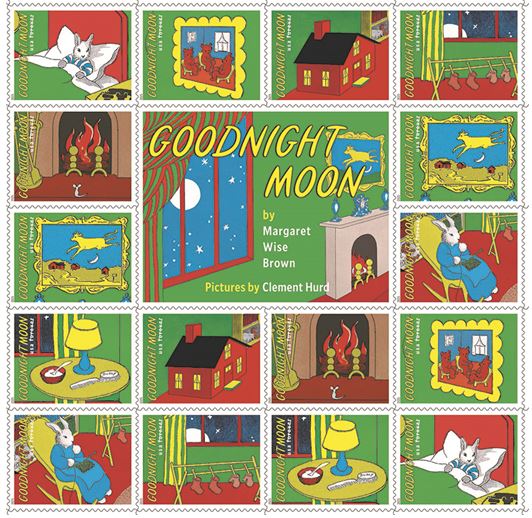May 2, 2025
Goodnight Moon Stamps Available Today
First-day-of-issue event held at The Rabbit hOle in North Kansas City, MO

North Kansas City, MO — The U.S. Postal Service unveiled stamps based on artwork from the classic children’s book “Goodnight Moon” at The Rabbit hOle, a museum that brings to life a century of American children’s literature, including the book’s iconic Great Green Room.
“These nostalgic stamps not only celebrate the timeless charm of ‘Goodnight Moon’ but also highlight the enduring relevance of both stamps and children’s literature in a digital age,” said Lisa Bobb-Semple, the Postal Service’s stamp services director, who spoke at the event. “The enthusiastic response from the public about these stamps has been exciting — a reminder that the joy of stamps continues to inspire all generations.”
Written by Margaret Wise Brown with artwork by Clement Hurd, “Goodnight Moon” revolutionized children’s publishing when it debuted in 1947 and has since become favorite bedtime reading for millions of families around the world. A celebration of the everyday, this quiet, lullaby-like book encourages children and their parents to imagine themselves in the book’s familiar Great Green Room, saying goodnight to everything they see. The sense of peace and security that the book brings helps ease children to sleep, reassuring them that all the familiar things of daily life will still be there in the morning.
Pete Cowdin, co-director of The Rabbit hOle, said the exhibit was an ideal setting for the stamps’ unveiling.
“We knew that the Great Green Room exhibit would kindle a powerful emotional connection with some of our visitors, but the impact of the room has exceeded our expectations. Walking into the exhibit is like walking into the book itself, a time machine that sets free a flood of memories and reconnects adults with their families and their own childhood. It reaffirms what we know already — that ‘Goodnight Moon’ is not just an American classic but a cultural touchstone that celebrates and spans all generations and all demographics.”
Children’s book creator and son of the illustrator of “Goodnight Moon,” Thacher Hurd read the book and discussed his father’s legacy as part of the unveiling.
“I’m sure Margaret and Clem would have loved the beautifully designed stamps created by Derry Noyes and USPS,” he said. “And it’s wonderful that the unveiling of the new ‘Goodnight Moon’ stamps will take place at The Rabbit hOle, with its delightful Great Green Room. It’s the perfect place for this exciting happening.”
One of the first books written for very young children that focuses on everyday experiences, “Goodnight Moon” reflects philosophical shifts in early childhood education that had begun in the early 20th century.
Brown wrote the first draft of “Goodnight Moon” one morning in 1945.
“In the great green room,” the book begins, “There was a telephone / And a red balloon.”
Told in spare, simple language, the book allows children to feel as if they are inside the cozy room, where a young bunny has been tucked into bed.
“Goodnight clocks / And goodnight socks,” reads the text. “Goodnight little house / And goodnight mouse.”
The lilting, hypnotic rhythm perfectly mimics the slow approach of sleep, casting a tender spell over young listeners, who bid goodnight to everything they see in the book — from the toy house and kittens playing on the bedroom floor to wall paintings, a red balloon, and the moon in the night sky. The book also encourages children and parents to look around their own rooms and improvise on the comforting bedtime ritual in any way they would like.
In early 1946, Brown sent the manuscript of “Goodnight Moon” to her friend Hurd (1908-1988), who spent most of the next year working on the book’s illustrations.
Hurd’s images alternate between panoramic scenes of the bedroom rendered in vibrant color and black-and-white close-ups of particular objects in the room, including a pair of mittens hung up to dry and an uneaten bowl of mush on the bedside table. His attention to detail has delighted generations of readers: A copy of “Goodnight Moon” sits upon the nightstand, the time on the clock moves forward, and a tiny mouse scurries about the room. At first brightly lit, the “great green room” grows gradually darker over the course of the book, echoing slumber's slow descent. In the final scene, the table lamp is off, the moon has risen, and the bowl of mush has been eaten.
Published by Harper & Bros. in September 1947, “Goodnight Moon” sold an initial 6,000 copies, but sales soon dropped off. The book’s remarkable rise in popularity began in the 1950s, in large part because of word of mouth among parents. In 1996, the New York Public Library, which did not add the book to its own collection until 1972, included “Goodnight Moon” on its Books of the Century list.
Today, “Goodnight Moon” has sold a total of more than 48 million copies, placing it among the best-selling children's books of all time.
Derry Noyes, an art director for the Postal Service, designed the pane using existing art by Hurd.
The Goodnight Moon pane of 16 stamps are issued as Forever stamps, which will always be equal in value to the current First-Class Mail 1-ounce price. News of the Goodnight Moon stamps are being shared with the hashtag #GoodnightMoonStamps.
Postal Products
Customers may purchase stamps and other philatelic products through the Postal Store at usps.com/shopstamps, by calling 844-737-7826, by mail through USA Philatelic or at Post Office locations nationwide. For officially licensed stamp products, shop the USPS Officially Licensed Collection on Amazon. Additional information on stamps, First Day of Issue Ceremonies and stamp inspired products can be found at StampsForever.com.
###
USPS NEWS
Media contacts
-
National contact: James McKean
[email protected] -
Local contact: Tara Jarrett
[email protected]

